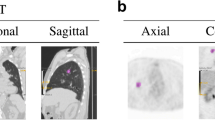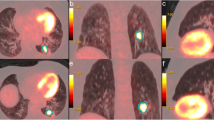Abstract
Purpose
18F-fluorodeoxyglocose positron emission tomography (FDG PET) plays a significant role in the diagnosis of cardiac sarcoidosis (CS). Texture analysis is a group of computational methods for evaluating the inhomogeneity among adjacent pixels or voxels. We investigated whether texture analysis applied to myocardial FDG uptake has diagnostic value in patients with CS.
Methods
Thirty-seven CS patients (CS group), and 52 patients who underwent FDG PET/CT to detect malignant tumors with any FDG cardiac uptake (non-CS group) were studied. A total of 36 texture features from the histogram, gray-level co-occurrence matrix (GLCM), gray-level run length matrix (GLRLM), gray-level zone size matrix (GLZSM) and neighborhood gray-level difference matrix (NGLDM), were computed using polar map images. First, the inter-operator and inter-scan reproducibility of the texture features of the CS group were evaluated. Then, texture features of the patients with CS were compared to those without CS lesions.
Results
Twenty-eight of the 36 texture features showed high inter-operator reproducibility with intraclass correlation coefficients (ICCs) over 0.80. In addition, 17 of the 36 showed high inter-scan reproducibility with ICCs over 0.80. The SUVmax showed no difference between the CS and non-CS group [7.36 ± 2.77 vs. 8.78 ± 4.65, p = 0.45, area under the curve (AUC) = 0.60]. By contrast, 16 of the 36 texture features could distinguish CS from non-CS grsoup with AUC > 0.80. Multivariate logistic regression analysis after hierarchical clustering concluded that long-run emphasis (LRE; P = 0.0004) and short-run low gray-level emphasis (SRLGE; P = 0.016) were significant independent factors that could distinguish between the CS and non-CS groups. Specifically, LRE was significantly higher in CS than in non-CS (30.1 ± 25.4 vs. 11.4 ± 4.6, P < 0.0001), with high diagnostic ability (AUC = 0.91), and had high inter-operator reproducibility (ICC = 0.98).
Conclusions
The texture analysis had high inter-operator and high inter-scan reproducibility. Some of texture features showed higher diagnostic value than SUVmax for CS diagnosis. Therefore, texture analysis may have a role in semi-automated systems for diagnosing CS.




Similar content being viewed by others
Abbreviations
- CMV:
-
Cardiac metabolic volume
- CMA:
-
Cardiac metabolic activity
- DA:
-
Descending aorta
- FDG:
-
18F-fluorodeoxyglucose
- HRS:
-
Heart Rhythm Society
- JSSOG:
-
Japanese Society of Sarcoidosis and Other Granulomatous disorders
- PET:
-
Positron emission tomography
- SUVmax:
-
Maximum standardized uptake value
- SUVmean:
-
Mean standardized uptake value
- VOI:
-
Volume-of-interest
References
Manabe O, Ohira H, Yoshinaga K, Naya M, Oyama-Manabe N, Tamaki N. Qualitative and quantitative assessments of cardiac sarcoidosis using 18F-FDG PET. Ann Nucl Cardiol. 2017;3:117–20.
Chareonthaitawee P, Beanlands RS, Chen W, et al. Joint SNMMI-ASNC expert consensus document on the role of (18)F-FDG PET/CT in cardiac sarcoid detection and therapy monitoring. J Nucl Cardiol. 2017;24:1741–58.
Terasaki F, Yoshinaga K. New guidelines for diagnosis of cardiac sarcoidosis in Japan. Annals of Nuclear Cardiology. 2017;3:42–5.
Ohira H, Mc Ardle B, deKemp R, et al. Inter- and intra- observer agreement of FDG-PET/CT image interpretation in patients referred for assessment of cardiac sarcoidosis. J Nucl Med. 2017;58:1324–9.
Yoshinaga K, Manabe O, Ohira H, Tamaki N. Focus issue on cardiac sarcoidosis from international congress of nuclear cardiology and cardiac CT(ICNC 12) symposium: improving the detectability of cardiac sarcoidosis―practical aspects of 18F- fluorodeoxyglucose positron emission tomography imaging for diagnosis of cardiac sarcoidosis―. Ann Nucl Cardiol. 2015;1:87–94.
Yokoyama R, Miyagawa M, Okayama H, et al. Quantitative analysis of myocardial 18F-fluorodeoxyglucose uptake by PET/CT for detection of cardiac sarcoidosis. Int J Cardiol. 2015;195:180–7.
Osborne MT, Hulten EA, Singh A, et al. Reduction in (1)(8)F-fluorodeoxyglucose uptake on serial cardiac positron emission tomography is associated with improved left ventricular ejection fraction in patients with cardiac sarcoidosis. J Nucl Cardiol. 2014;21:166–74.
Ahmadian A, Brogan A, Berman J, et al. Quantitative interpretation of FDG PET/CT with myocardial perfusion imaging increases diagnostic information in the evaluation of cardiac sarcoidosis. J Nucl Cardiol. 2014;21:925–39.
Schildt JV, Loimaala AJ, Hippelainen ET, Ahonen AA. Heterogeneity of myocardial 2-[18F]fluoro-2-deoxy-D-glucose uptake is a typical feature in cardiac sarcoidosis: a study of 231 patients. Eur Heart J Cardiovasc Imaging. 2018;19:293–8.
Sperry BW, Tamarappoo BK, Oldan JD, et al. Prognostic impact of extent, severity, and heterogeneity of abnormalities on 18F-FDG PET scans for suspected cardiac sarcoidosis. JACC Cardiovasc Imaging. 2018;11:336–45.
Orlhac F, Soussan M, Maisonobe JA, Garcia CA, Vanderlinden B, Buvat I. Tumor texture analysis in 18F-FDG PET: relationships between texture parameters, histogram indices, standardized uptake values, metabolic volumes, and total lesion glycolysis. J Nucl Med. 2014;55:414–22.
Orlhac F, Theze B, Soussan M, Boisgard R, Buvat I. Multiscale texture analysis: from 18F-FDG PET images to histologic images. J Nucl Med. 2016;57:1823–8.
Yu H, Caldwell C, Mah K, et al. Automated radiation targeting in head-and-neck cancer using region-based texture analysis of PET and CT images. Int J Radiat Oncol Biol Phys. 2009;75:618–25.
Hatt M, Majdoub M, Vallieres M, et al. 18F-FDG PET uptake characterization through texture analysis: investigating the complementary nature of heterogeneity and functional tumor volume in a multi-cancer site patient cohort. J Nucl Med. 2015;56:38–44.
Manabe O, Yoshinaga K, Ohira H, et al. The effects of 18-h fasting with low-carbohydrate diet preparation on suppressed physiological myocardial (18)F-fluorodeoxyglucose (FDG) uptake and possible minimal effects of unfractionated heparin use in patients with suspected cardiac involvement sarcoidosis. J Nucl Cardiol. 2016;23:244–52.
Manabe O, Kroenke M, Aikawa T, et al. Volume-based glucose metabolic analysis of FDG PET/CT: the optimum threshold and conditions to suppress physiological myocardial uptake. J Nucl Cardiol. 2017. https://doi.org/10.1007/s12350-017-1122-6.
Yamagishi H, Akioka K, Hirata K, et al. A reverse flow-metabolism mismatch pattern on PET is related to multivessel disease in patients with acute myocardial infarction. J Nucl Med. 1999;40:1492–8.
Mc Ardle BA, Birnie DH, Klein R, et al. Is there an association between clinical presentation and the location and extent of myocardial involvement of cardiac sarcoidosis as assessed by (1)(8)F- fluorodoexyglucose positron emission tomography? Circ Cardiovasc Imaging. 2013;6:617–26.
Ito K, Okazaki O, Morooka M, Kubota K, Minamimoto R, Hiroe M. Visual findings of (18)F-fluorodeoxyglucose positron emission tomography/computed tomography in patients with cardiac sarcoidosis. Intern Med. 2014;53:2041–9.
Tavora F, Cresswell N, Li L, Ripple M, Solomon C, Burke A. Comparison of necropsy findings in patients with sarcoidosis dying suddenly from cardiac sarcoidosis versus dying suddenly from other causes. Am J Cardiol. 2009;104:571–7.
Mir AH, Hanmandlu M, Tandon SN. Texture analysis of CT-images for early detection of liver malignancy. Biomed Sci Instrum. 1995;31:213–7.
Schad LR, Bluml S, Zuna I. MR tissue characterization of intracranial tumors by means of texture analysis. Magn Reson Imaging. 1993;11:889–96.
Hatt M, Tixier F, Pierce L, Kinahan PE, Le Rest CC, Visvikis D. Characterization of PET/CT images using texture analysis: the past, the present... Any future? Eur J Nucl Med Mol Imaging. 2017;44:151–65.
Baessler B, Mannil M, Oebel S, Maintz D, Alkadhi H, Manka R. Subacute and Chronic left ventricular myocardial scar: accuracy of texture analysis on nonenhanced cine MR images. Radiology. 2018;286:103–12.
Larroza A, Materka A, Lopez-Lereu MP, Monmeneu JV, Bodi V, Moratal D. Differentiation between acute and chronic myocardial infarction by means of texture analysis of late gadolinium enhancement and cine cardiac magnetic resonance imaging. Eur J Radiol. 2017;92:78–83.
Papp L, Poetsch N, Grahovac M, et al. Glioma survival prediction with the combined analysis of in vivo 11C-MET-PET, ex vivo and patient features by supervised machine learning. J Nucl Med. 2018;59:892–9.
Yip S, McCall K, Aristophanous M, Chen AB, Aerts HJ, Berbeco R. Comparison of texture features derived from static and respiratory-gated PET images in non-small cell lung cancer. PLoS One. 2014;9:e115510.
Oliver JA, Budzevich M, Zhang GG, Dilling TJ, Latifi K, Moros EG. Variability of image features computed from conventional and respiratory-gated PET/CT images of lung cancer. Transl Oncol. 2015;8:524–34.
Acknowledgements
We thank Eriko Suzuki, MT for her support of this study.
Author information
Authors and Affiliations
Corresponding author
Ethics declarations
Ethical approval
All procedures performed in studies involving human participants were in accordance with the ethical standards of the institutional and/or national research committee and with the principles of the 1964 Declaration Helsinki and its later amendments or comparable ethical standards.
Conflict of interest
All authors have no conflicts of interest to disclose.
Informed consent
Written informed consent was obtained prior to the study for the CS patients and with a waiver of the need for written informed consent for the control group.
Electronic supplementary material
ESM 1
(DOCX 86 kb)
Rights and permissions
About this article
Cite this article
Manabe, O., Ohira, H., Hirata, K. et al. Use of 18F-FDG PET/CT texture analysis to diagnose cardiac sarcoidosis. Eur J Nucl Med Mol Imaging 46, 1240–1247 (2019). https://doi.org/10.1007/s00259-018-4195-9
Received:
Accepted:
Published:
Issue Date:
DOI: https://doi.org/10.1007/s00259-018-4195-9




